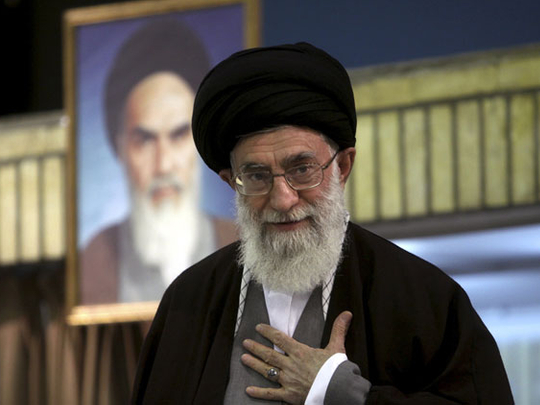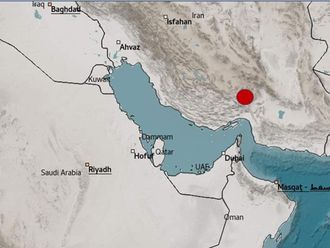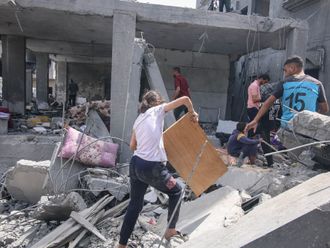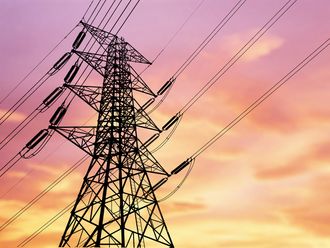
New York: The 82-year-old Iranian woman keeps the documents that upended her life in an old suitcase near her bed.
She removes them carefully and peers at the tiny Farsi script.
There’s the court order authorising the takeover of her children’s three Tehran apartments in a multi-story building the family had owned for years. There’s the letter announcing the sale of one of the units. And there’s the notice demanding she pay rent on her own apartment on the top floor.
Pari Vahdat-e-Hagh ultimately lost her property. It was taken by an organisation that is controlled by the most powerful man in Iran: Supreme Leader Ayatollah Ali Khamenei. She now lives alone in a cramped, three-room apartment in Europe, thousands of miles from Tehran.
The Farsi name of the organisation that hounded her for years is “Setad Ejraiye Farmane Hazrate Emam” — Headquarters for Executing the Order of the Imam. The name refers to an edict signed by the Islamic Republic’s first leader, Ayatollah Ruhollah Khomeini, shortly before his death in 1989. His order spawned a new entity to manage and sell properties abandoned in the chaotic years after the 1979 Islamic Revolution.
Setad has become one of the most powerful organisations in Iran, though many Iranians, and the wider world, know very little about it. In the past six years, it has morphed into a business juggernaut that now holds stakes in nearly every sector of Iranian industry, including finance, oil, telecommunications, the production of birth-control pills and even ostrich farming.
The organisation’s total worth is difficult to pinpoint because of the secrecy of its accounts. But Setad’s holdings of real estate, corporate stakes and other assets total about $95 billion. That estimate is based on an analysis of statements by Setad officials, data from the Tehran Stock Exchange and company websites, and information from the US Treasury Department.
Just one person controls that economic empire — Khamenei. As Iran’s top cleric, he has the final say on all governmental matters. His purview includes his nation’s controversial nuclear programme, which was the subject of intense negotiations between Iranian and international diplomats in Geneva that ended on Sunday without an agreement. It is Khamenei who will set Iran’s course in the nuclear talks and other recent efforts by the new president, Hassan Rouhani, to improve relations with Washington.
The supreme leader’s acolytes praise his spartan lifestyle, and point to his modest wardrobe and a threadbare carpet in his Tehran home. Reuters found no evidence that Khamenei is tapping Setad to enrich himself.
But Setad has empowered him. Through Setad, Khamenei has at his disposal financial resources whose value rivals the holdings of the shah, the Western-backed monarch who was overthrown in 1979.
How Setad came into those assets also mirrors how the deposed monarchy obtained much of its fortune — by confiscating real estate. Setad built its empire on the systematic seizure of thousands of properties belonging to ordinary Iranians: members of religious minorities like Vahdat-e-Hagh, who is Baha’i, as well as Shiite Muslims, business people and Iranians living abroad.
Setad has amassed a giant portfolio of real estate by claiming in Iranian courts, sometimes falsely, that the properties are abandoned. The organisation now holds a court-ordered monopoly on taking property in the name of the supreme leader, and regularly sells the seized properties at auction or seeks to extract payments from the original owners.
The supreme leader also oversaw the creation of a body of legal rulings and executive orders that enabled and safeguarded Setad’s asset acquisitions. “No supervisory organisation can question its property,” said Naghi Mahmoudi, an Iranian lawyer who left Iran in 2010 and now lives in Germany.
Khamenei’s grip on Iran’s politics and its military forces has been apparent for years. The investigation into Setad shows that there is a third dimension to his power: economic might.
The revenue stream generated by Setad helps explain why Khamenei has not only held on for 24 years but also in some ways has more control than even his revered predecessor. Setad gives him the financial means to operate independently of parliament and the national budget, insulating him from Iran’s messy factional infighting.
Washington has acknowledged Setad’s importance. In June, the Treasury Department imposed sanctions on Setad and some of its corporate holdings, calling the organisation “a massive network of front companies hiding assets on behalf of Iran’s leadership.” The companies generate billions of dollars in revenue a year, the department stated, but it did not offer a detailed accounting.
The Iranian president’s office and the foreign ministry didn’t respond to requests for comment. Iran’s embassy in the UAE issued a statement calling the findings “scattered and disparate” and said that “none has any basis.” It didn’t elaborate.
Setad’s director general of public relations, Hamid Vaezi, said by email in response to a detailed description of this series that the information presented is “far from realities and is not correct.” He didn’t go into specifics.
When Khomeini, the first supreme leader, set in motion the creation of Setad, it was only supposed to manage and sell properties “without owners” and direct much of the proceeds to charity. Setad was to use the funds to assist war veterans, war widows “and the downtrodden.” According to one of its co-founders, Setad was to operate for no more than two years.
Setad has built schools, roads and health clinics, and provided electricity and water in rural and impoverished areas.
It has assisted entrepreneurs in development projects. But philanthropy is just a small part of Setad’s overall operations.
Under Khamenei’s control, Setad began acquiring property for itself, and kept much of the funds rather than simply redistributing them. With those revenues, the organisation also helps to fund the ultimate seat of power in Iran, the Beite Rahbar, or Leader’s House, according to a former Setad employee and other people familiar with the matter. The first supreme leader, Khomeini, had a small staff. To run the country today, Khamenei employs about 500 people in his administrative offices, many recruited from the military and security services.
A complete picture of Setad’s spending and income isn’t possible. Its books are off limits even to Iran’s legislative branch. In 2008, the Iranian Parliament voted to prohibit itself from monitoring organisations that the supreme leader controls, except with his permission.
According to a Treasury spokesman, sanctions only apply to subsidiaries if the targeted entity “owns 50 per cent or more of a company.” In practice, Setad controls many businesses in which it holds very small stakes. Reuters identified at least 24 public companies in which Setad — or a company it invested in — held less than 50 per rcent. Those holdings that are publicly traded are worth more than $3.4 billion, Reuters calculated. That figure includes about $3 billion Setad paid in 2009 for a stake in Iran’s largest telecommunications firm.
Reuters also identified 14 companies Setad has invested in — directly or through other companies — that couldn’t be valued because they are not publicly traded.
All told, Reuters was able to identify about $95 billion in property and corporate assets controlled by Setad. That amount is roughly 40 per cent bigger than the country’s total oil exports last year. It also surpasses independent historians’ estimates of the late shah’s wealth.
After toppling the monarchy, the Islamic Republic filed suit in the US against the shah and his wife, Farah Pahlavi, claiming they had stolen $35 billion in Iranian funds, according to court records. In today’s dollars, that sum would be worth about $79 billion. The suit was dismissed.
Abbas Milani, director of the Iranian Studies programme at Stanford University who wrote a biography of the shah published in 2011, said he believes the estimate of the shah’s fortune was “extremely exaggerated.” He said the monarch led a truly opulent lifestyle —including owning an automobile collection that may have included 120 fancy vehicles. But, he wrote in the biography: “Those most likely to know estimate the Shah’s fortune to be close to a billion dollars.” With inflation, that would equal about $3 billion in today’s money, a fraction of the worth of Setad’s holdings.












